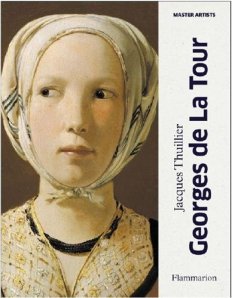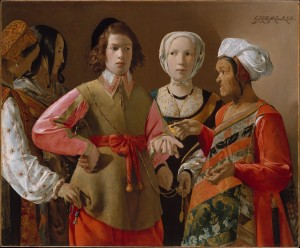 March
13
March
13
Tags
The Mystery of ‘The Fortune Teller’ by Georges de la Tour
 On the 13th of March 1593, the French Baroque painter Georges de la Tour was born in the town of Vic-sur-Seuille, a few miles from Nancy, France. In 1620, when he was already a practicing painter, he moved to Lunéville, Lorraine, an independent duchy between north-east France and the German states. That is where he established himself as a master artist and stayed until his death in 1652. Until 1915, when Hermann Voss practically rescued him from oblivion, La Tour’s life and oeuvre had been relatively unknown. Even now, there are still very few documents providing much information about his life and education, but some of the scholars say that a travel to either Italy or the Netherlands in the early stages of his career was very likely to happen. His paintings bear visible Caravaggian influences, which probably reached him through the Dutch Caravaggisti of the Utrecht School and other French and Dutch contemporaries. But unlike Caravaggio, La Tour’s religious paintings lack the typical dramatic effect.
On the 13th of March 1593, the French Baroque painter Georges de la Tour was born in the town of Vic-sur-Seuille, a few miles from Nancy, France. In 1620, when he was already a practicing painter, he moved to Lunéville, Lorraine, an independent duchy between north-east France and the German states. That is where he established himself as a master artist and stayed until his death in 1652. Until 1915, when Hermann Voss practically rescued him from oblivion, La Tour’s life and oeuvre had been relatively unknown. Even now, there are still very few documents providing much information about his life and education, but some of the scholars say that a travel to either Italy or the Netherlands in the early stages of his career was very likely to happen. His paintings bear visible Caravaggian influences, which probably reached him through the Dutch Caravaggisti of the Utrecht School and other French and Dutch contemporaries. But unlike Caravaggio, La Tour’s religious paintings lack the typical dramatic effect.
“La Tour was above all an unexpected painter; in the provincial seclusion of Lunéville, not tied to any rigid tradition, he occasionally found formulae for his pictorial ideas which were highly original and personal. The content of his paintings is not unambiguous; his interpretation of ‘Caravaggism’ appears too light-hearted and somewhat capricious, his sense of veracity is fragile, his presentation and vision tend towards the archaic, with a certain admixture of Mannerist habits. Even though the onlooker of our day may find his paintings… impressive, ‘modern’ and, if this expression is preferred, cubist, their plastic sense is startling and sophisticated rather than convincing. To us, La Tour seems a highly gifted amateur, uneven in his craftsmanship, at times naive, at other times rather given to affectation; without firm roots in any tradition, although highly susceptible to, and dependent on, the style of his native country…; avoiding the main current of European painting; playing with ‘truth’ and ‘beauty’ as though they were dice; progressive and old-fashioned at the same time.” (Vitale Bloch, Georges de la Tour Once Again, The Burlington Magazine, Vol. 96, No. 612, Mar., 1954)
 It is believed that within his thirty years career La Tour produced about forty paintings; some of them could have been painted by his son, Étienne. In fact, there have been problems with attribution to some of his paintings and many speculations that some of them could be forgeries. One of such paintings is The Fortune Teller, which portrays a 17th-century picaresque scene: a fortune teller and three sly thieves in the act of robbing a young man. The latter’s attention is fully occupied by an old woman who is about to tell his fortune by reading his palm. He is totally unaware of the fact that the girl to his right is removing his purse from his pocket, while at the same time a pale-skinned beauty is cutting a gold medal from the chain around his neck. Some of the scholars claim that the figures in the painting look like actors on a stage and that the painter could have borrowed the scene from a play. However, considering that the act of fortune telling is about revealing the future, and also that majority of the questions posed to clairvoyants are usually love-related, one could see this scene as a two-dimensional metaphor on one man’s future love life. The women surrounding the man are from different social groups and backgrounds. Therefore it would be most unlikely for them to cooperate together in this, what it looks like, ‘organised’ theft. They are rather to represent the man’s future amorous adventures, which all seem to lead to the same conclusion: women are most attracted by a man’s status and wealth.
It is believed that within his thirty years career La Tour produced about forty paintings; some of them could have been painted by his son, Étienne. In fact, there have been problems with attribution to some of his paintings and many speculations that some of them could be forgeries. One of such paintings is The Fortune Teller, which portrays a 17th-century picaresque scene: a fortune teller and three sly thieves in the act of robbing a young man. The latter’s attention is fully occupied by an old woman who is about to tell his fortune by reading his palm. He is totally unaware of the fact that the girl to his right is removing his purse from his pocket, while at the same time a pale-skinned beauty is cutting a gold medal from the chain around his neck. Some of the scholars claim that the figures in the painting look like actors on a stage and that the painter could have borrowed the scene from a play. However, considering that the act of fortune telling is about revealing the future, and also that majority of the questions posed to clairvoyants are usually love-related, one could see this scene as a two-dimensional metaphor on one man’s future love life. The women surrounding the man are from different social groups and backgrounds. Therefore it would be most unlikely for them to cooperate together in this, what it looks like, ‘organised’ theft. They are rather to represent the man’s future amorous adventures, which all seem to lead to the same conclusion: women are most attracted by a man’s status and wealth.
The painting had been seen by hardly anyone before 1960, and the story of its discovery is mysterious. It is said that in 1942 a monograph on the works of La Tour got into the hands of a French prisoner-of-war. The reproductions in the book reminded him of an old painting which he had seen at his uncle’s castle. Once the war ended, he had the painting examined by a priest, who, after concluding that the painting was a genuine La Tour, contacted the Louvre. Secret negotiations were then conducted, but the art dealer Georges Wildenstein outbid the Louvre and bought the painting in 1949 for 7.5 million francs. It remained in his possession for the next ten years, until the Metropolitan Museum acquired it in 1960. Due to its relatively unknown origins, the painting was at some point claimed to be a nineteenth century forgery. This was, however, later discredited by Pierre Rosenberg who said: “…it is inconceivable that a forger could have painted a false La Tour in the nineteenth century. Even if documents on the life of the painter had already been published, his works were still unknown and no one was interested in them.” (Pierre Rosenberg, The Fortune Teller by Georges de la Tour, The Burlington Magazine, Vol. 123, No. 941, Aug., 1981).











Reblogged this on Lenora's Culture Center and Foray into History.
LikeLike
Reblogged this on Greek Canadian Literature.
LikeLike